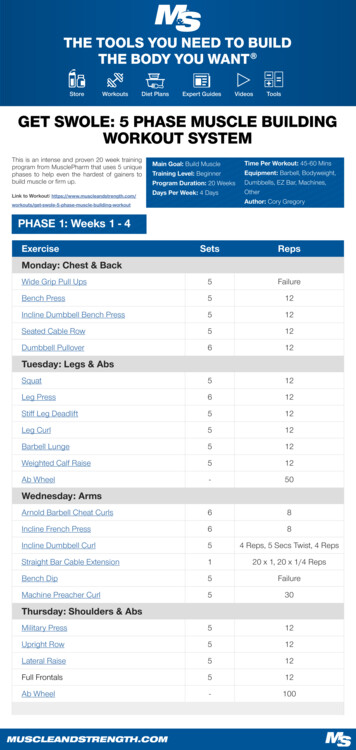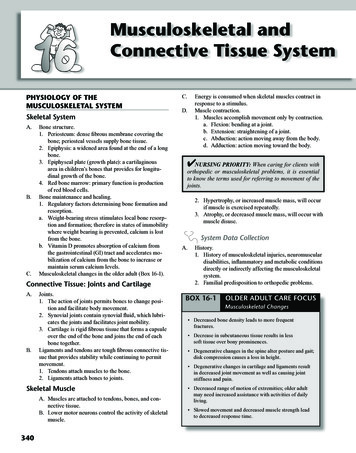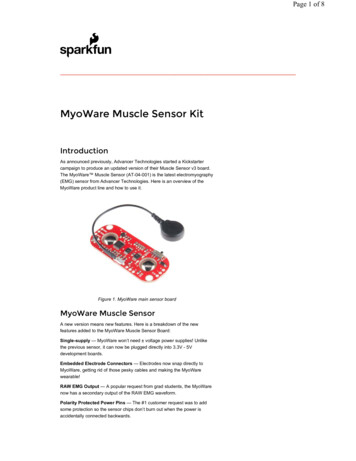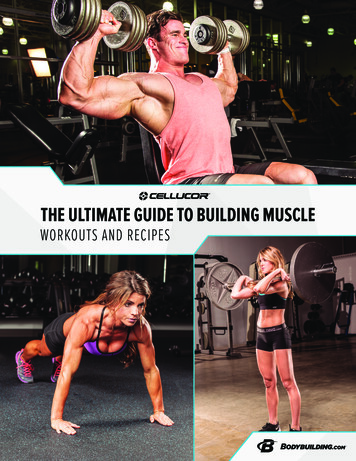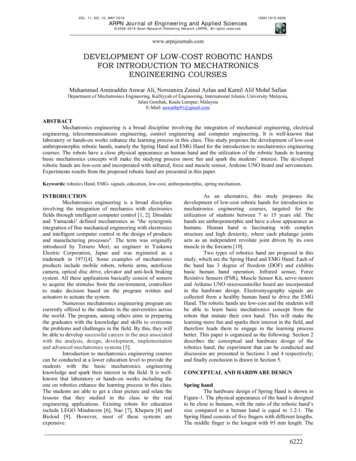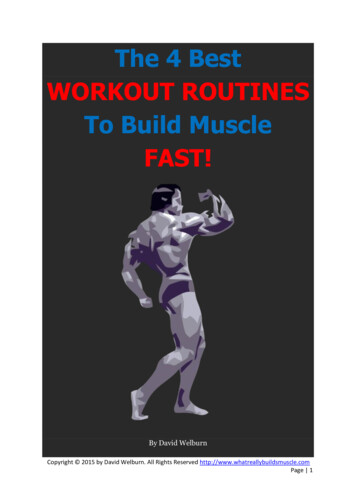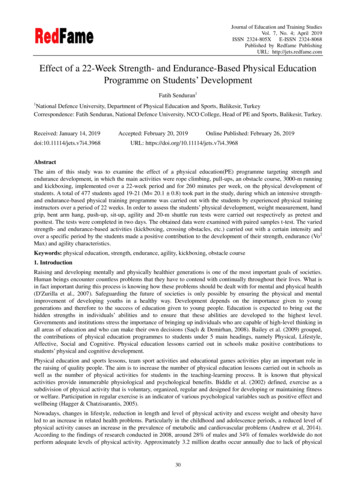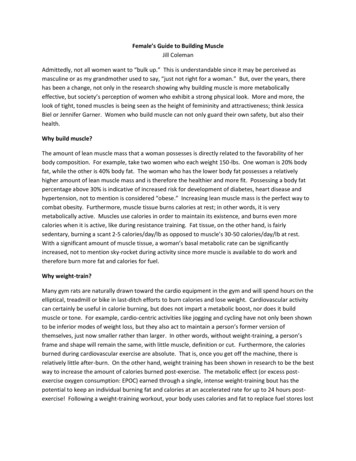
Transcription
Female’s Guide to Building MuscleJill ColemanAdmittedly, not all women want to “bulk up.” This is understandable since it may be perceived asmasculine or as my grandmother used to say, “just not right for a woman.” But, over the years, therehas been a change, not only in the research showing why building muscle is more metabolicallyeffective, but society’s perception of women who exhibit a strong physical look. More and more, thelook of tight, toned muscles is being seen as the height of femininity and attractiveness; think JessicaBiel or Jennifer Garner. Women who build muscle can not only guard their own safety, but also theirhealth.Why build muscle?The amount of lean muscle mass that a woman possesses is directly related to the favorability of herbody composition. For example, take two women who each weight 150-lbs. One woman is 20% bodyfat, while the other is 40% body fat. The woman who has the lower body fat possesses a relativelyhigher amount of lean muscle mass and is therefore the healthier and more fit. Possessing a body fatpercentage above 30% is indicative of increased risk for development of diabetes, heart disease andhypertension, not to mention is considered “obese.” Increasing lean muscle mass is the perfect way tocombat obesity. Furthermore, muscle tissue burns calories at rest; in other words, it is verymetabolically active. Muscles use calories in order to maintain its existence, and burns even morecalories when it is active, like during resistance training. Fat tissue, on the other hand, is fairlysedentary, burning a scant 2-5 calories/day/lb as opposed to muscle’s 30-50 calories/day/lb at rest.With a significant amount of muscle tissue, a woman’s basal metabolic rate can be significantlyincreased, not to mention sky-rocket during activity since more muscle is available to do work andtherefore burn more fat and calories for fuel.Why weight-train?Many gym rats are naturally drawn toward the cardio equipment in the gym and will spend hours on theelliptical, treadmill or bike in last-ditch efforts to burn calories and lose weight. Cardiovascular activitycan certainly be useful in calorie burning, but does not impart a metabolic boost, nor does it buildmuscle or tone. For example, cardio-centric activities like jogging and cycling have not only been shownto be inferior modes of weight loss, but they also act to maintain a person’s former version ofthemselves, just now smaller rather than larger. In other words, without weight-training, a person’sframe and shape will remain the same, with little muscle, definition or cut. Furthermore, the caloriesburned during cardiovascular exercise are absolute. That is, once you get off the machine, there isrelatively little after-burn. On the other hand, weight training has been shown in research to be the bestway to increase the amount of calories burned post-exercise. The metabolic effect (or excess postexercise oxygen consumption: EPOC) earned through a single, intense weight-training bout has thepotential to keep an individual burning fat and calories at an accelerated rate for up to 24 hours postexercise! Following a weight-training workout, your body uses calories and fat to replace fuel stores lost
during exercise, shuttle blood and metabolites around for tissue repair, and bring your heart andbreathing rates down, all of which is on-going post-workout.Working out with weights not only boosts your metabolism through muscle building and generatingEPOC, but improves bone mineral density. The act of lifting a weight forces the muscles to contract andpull on the muscle’s insertion points which attach to bones, creating the joint movement. It is thepulling of these insertion points on bone that actually activates new bone growth. Study after studyshows weight-training’s ability to prevent bone loss and prevent osteoporosis. Thus, lean muscle massis invaluable for women of all ages—it’s metabolically efficient, it imparts a certain amount ofprevention against disease, it builds bone and oh—it looks good too! Weight training, along with soundmuscle-building nutrition, is the only way to build significant muscle mass. Follow these protocols tolook, feel and be your strongest.Your muscle-building workoutIt is not enough to simply pick up some weights and lift them. There are certain protocols and programsthat work best for women, simply because a woman’s hormonal environment only allows her to build somuch muscle. Testosterone and growth hormone are important metabolic messengers that whenreleased during intense weight-training can have a significant effect on muscle building. By nature,women have much less of the anabolic hormone, testosterone than men. High testosterone productionallows for significant increases in lean body mass, as is witnessed during adolescence when both girlsand boys’ testosterone surges, leading to growth spurts. Because women have less than men, theymust do things, such as weight-train a certain way to increase it naturally and harness its power intomuscle-building. Growth hormone (GH) is also an anabolic hormone that is released in response tointense weight-training and not only contributes to muscle building, but also to fat-burning,mineralization of bone and immune system function.The act of building muscle size, or hypertrophy, is a science that requires two types of exercise protocols,as well as progressive resistance. The first exercise protocol, called myofibrillar hypertrophy involvesusing relatively heavy weight and performing sets of 2 to 8 repetitions to increase the quantity and sizeof the muscle’s contractile apparatuses, revealing a larger limb. A person should reach close to thepoint of mechanical failure by the 7th or 8th repetition; in other words, the weight should be too heavy tolift. This induction of failure serves to increase testosterone release and increase microtrauma to themuscle fibers. Microtrauma is the generation of small muscle tears during weight training and is thebasis for hypertrophy. When this occurs, the muscle repair process effectively replaces the damagedmuscle with stronger and larger tissue so that the tissue can withstand that same stress load in thefuture. Progressive resistance, or increasing resistance as the workouts progress, allows for the musclesto handle increased workloads and continually create micro tears to the muscles to increase musclemass. To perform a myofibrillar hypertrophy protocol, perform 4-6 sets (2-8 reps each) and rest 1-2minutes in between sets. Here is an example upper-body workout for an intermediate female exerciser:
ExerciseWeightRepetitionsFlat Bench Barbell Press75lbs6Barbell Bent-over Row85lbs8Seated DumbbellShoulder Press25lbs6DipsBodyweightAs many as possible up to 8Dumbbell Biceps Curl20lbs6 ea sideHanging Leg RaiseBodyweight8The second useful protocol is elicits sarcoplasmic hypertrophy, characterized by an increase insarcoplasmic fluid within the muscle cells, allowing the muscles to grow and appear larger. This type oftraining yields the greatest strength gains in beginners and is used to prime one’s neuromuscularsystem, leading to fast gains in strength within the first couple weeks of training. The sarcoplasmichypertrophy protocol calls for 12-15 repetitions per exercise, 4 sets total, with 1 minute or less rest inbetween sets. This is an extremely voluminous workout that moves quickly and yields an aerobiccomponent as a result. The best way to do this program is to circuit train. Choose 3-4 exercises andperform them back to back in circuit fashion, resting minimally in between sets. You may worksynergistic muscle groups (increases workout difficulty) or opposing muscle groups. Here is an exampleof a typical circuit that yields a sarcoplasmic hypertrophic outcome for an intermediate female trainee:ExerciseWeightRepetitionsIncline DumbbellChest Press20lb15Incline DumbbellChest Fly20lbs12Bench DipsBodyweight15Dumbbell Side Raise15lbs12This type of training does not induce mechanical failure as quickly, but instead elicits a muscular burningthat signals a rise in lactic acid that needs clearance, eventually inducing failure that way. This type offailure (metabolic) releases more growth hormone, likewise necessary for muscle building.
The final aspect of the training section of muscle building is the rest needed to repair and build larger,stronger muscles. Many fitness experts advise 48 hours, however, for best results, allow at least 72hours between these intense weight-training programs outlined here. Longer rest days betweenworkouts will allow the muscles to fully recover, as well as help the trainee push even harder the nextworkout. Too many workouts in a row will ultimately lead to muscle overtraining, which inevitably leadsto muscle catabolism!Your muscle-building dietBuilding lean muscle mass is impossible without correct nutrition. Interestingly, it is fairly easy to eat formuscle gain since both calories and carbohydrates are needed in large quantities. However, to preventfat gain while only building lean muscle, a specific nutrition plan is needed: maximize muscle buildingand minimize fat storing. Pre workout (60-90 minutes prior), consume a small meal containing bothcarbohydrates and protein (close to a 50-50 ratio). This type of snack will make energy available toassure an intense workout, but will limit fat-storing potential. An example is a small bowl of naturaloatmeal with a ½ scoop of whey protein powder and 1-2 tbsp of natural peanut butter.The art of hypertrophy, however, lies mostly in an individual’s post-exercise nutrition. Post exercise,carbohydrate intake in critical, ideally within the first 30 minutes after weight-training. During intenseexercise, blood glucose and usually glycogen stores are depleted and need to be replenished. At thesame time, however, muscle break-down occurs, which merits substantial protein intake also. The goalof a post-workout, muscle-building meal is to deliver protein to muscles for repair and reinforcementwhile also repleting muscle glycogen. Exercise itself is a catabolic act, breaking down muscle and usingup fuel reserves; however, consuming lean protein and high-quality carbs post-workout will allow thebody to remain anabolic. Immediately following exercise, the body is in a depleted state and muscletissue will devour anything that can be used for fuel: the muscles are sponge-like at this point andcareful consideration should be given to food choices. Whey protein is one of the most quicklyabsorbed types of protein and is convenient. Other options include egg whites, ground beef and evenmilk. A carbohydrate source should be insulinigenic since insulin accelerates protein uptake by themuscles and facilitates muscle growth. Good carbohydrate sources for after an intense weight-trainingsession include simple sugar-containing foods like honey and bananas.Other factors affecting muscle buildingMany women claim that they bulk up quickly, but surprisingly, it is actually not all that easy for womento put on substantial muscle because of our hormonal make-up. However, in addition to exercise andnutrition, there are other tools and techniques that assist the body’s ability to build lean muscle mass.Sleep, for example is powerful in releasing growth hormone. In fact, growth hormone levels cycle upand down throughout the day and one of the peak times of growth hormone release is within an hour ofthe onset of sleep. Be sure to get at least 8 hours of sleep each night to maximize GH’s muscle-buildingpotential. Consumption of dietary protein outside of pre- and post-workout meals is likewise beneficialin maintaining muscle mass. As long as dietary protein sufficiently maintains the body’s amino acidpools, the body will not have to strip muscle for other protein use. Certain supplemental complexes
have been shown to increase muscle size and strength, including creatine, glutamine and arginine. Cribbet al. showed that a creatine, along with carbohydrate, supplement significantly increased muscle fibersize in participants performing resistance training, over a carbohydrate-only supplement (Medicine andScience in Sports and Exercise. 2007, vol 39). Along with stimulating the release of growth hormone,glutamine is an anabolic amino acid whose muscle stores limit the amount of muscle mass that canpossibly be generated. Anyone trying to build muscle will need to make this amino acid available to themuscles (0.5mg of glutamine per kilogram of body weight is the recommended level to yield anabolism).Finally, the amino acid arginine has been shown to elicit the release of somatotropin uponsupplementation. Somatotropin is an insulin-like growth factor, stimulating protein (i.e. muscle)synthesis. It likewise facilitates growth hormone release.“Just RIGHT for a woman”Weight-training and smart, sound nutrition form the cornerstone of a woman’s muscle buildingpotential. No supplement, amount of sleep or endless cardio will do the trick if these measures are notin place. Once they are, however, liberal consumption of lean protein maintains healthy muscle toneand mass. Remember to train heavy, train to failure and use both exercise protocols outlined here toultimately reap big, bulky benefits in building lean muscle tissue and in effect, a stronger, healthier,leaner you!
of a post-workout, muscle-building meal is to deliver protein to muscles for repair and reinforcement while also repleting muscle glycogen. Exercise itself is a catabolic act, breaking down muscle and using up fuel reserves; however, consuming lean protein and high-quality carbs post-workout

